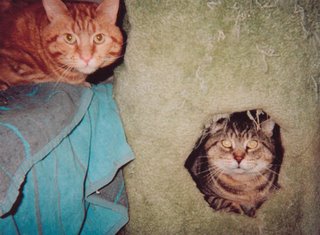
Meet Harry (the ginger one) amd Toby (the tabby). They are both about 5 years old, strays that were put together as SNIP had no room to keep them separate, and now they adore each other!
Toby is a big, solid muscley cat with a tattered ear, who is very shy at first so needs time to get to know you. Harry is braver, and the sweetest cat you could wish to meet.
They must be homed together as they are so devoted to each other. They have been waiting a long time for the right person to love them, as Toby in particular won't show his face if anyone comes to see them.
They have been used to going outside so need a garden. Could you give these lovely lads a second chance? Give SNIP a call on 0700 594 7647 or email your details to snip@pussy-cat.co.uk and someone will contact you.

Meet Harry (the ginger one) amd Toby (the tabby). They are both about 5 years old, strays that were put together as SNIP had no room to keep them separate, and now they adore each other!
Toby is a big, solid muscley cat with a tattered ear, who is very shy at first so needs time to get to know you. Harry is braver, and the sweetest cat you could wish to meet.
They must be homed together as they are so devoted to each other. They have been waiting a long time for the right person to love them, as Toby in particular won't show his face if anyone comes to see them.
They have been used to going outside so need a garden. Could you give these lovely lads a second chance? Give SNIP a call on 0700 594 7647 or email your details to snip@pussy-cat.co.uk and someone will contact you.


